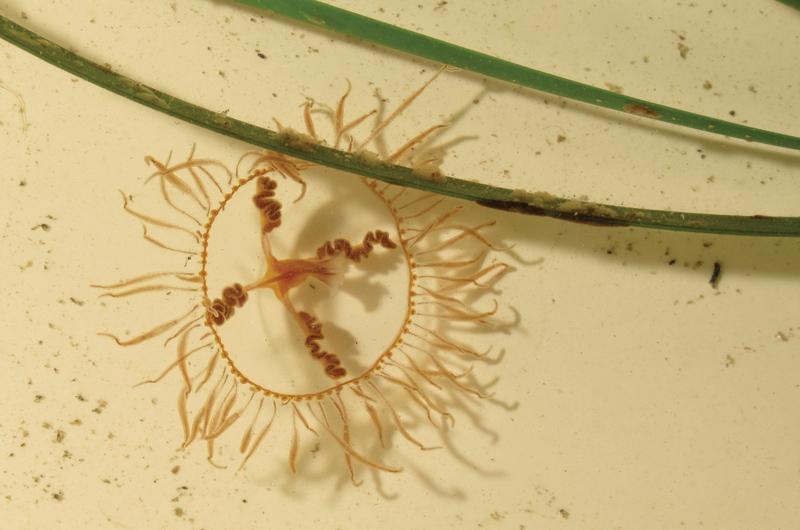Last summer, signs on Vineyard beaches warned swimmers about Portuguese man-of-wars, the brightly colored siphonophores that deliver a painful sting. And anyone who has spent much time in the water in the summer is probably familiar with the big, pink jellyfish and the small harmless moon jellies of August. But there is a new gelatinous menace lurking in Vineyard ponds, largely unknown and barely visible.
The tiny but formidable creature is Gonionemus vertens, also called the clinging jellyfish. G. vertens is about the size of a quarter but can expand to about three inches in diameter. Unlike the more familiar jellies, which swim or drift with their tentacles free-flowing, the sixty to ninety tentacles of the G. vertens have adhesive pads at their ends – hence the clinging nickname.

Clinging jellyfish eat small crustaceans, like copepods, and have a cross marking in their transparent bell. They are native to the Pacific Ocean, but are increasingly found
in Atlantic waters. Last summer, Woods Hole Oceanographic Institute biologist Mary Carman came face-to-face – quite literally – with their presence in Farm Pond in Oak Bluffs.
Carman’s area of research is tunicates, or sea squirts, and it was those ancient invertebrates’ relationship to eelgrass that took her to Farm Pond, where she was collecting specimens from the pond floor. The water there is murky, calm, and full of eelgrass – ideal conditions, as it turns out, for G. vertens.
“I’ve never been stung by a jellyfish before,” said Carman. She’s seen the warning signs for Portuguese man-of-wars, she said, but had never thought to look out for the clinging jellyfish, which in a relaxed state is scarcely the width of a blade of eelgrass. “These little guys are very camouflaged.”
It was a complete shock, therefore, when she disrupted a clinging jellyfish and got stung on the lips. “It was just terrible,” she recalled, noting that the lips are an especially painful place to be stung. “It felt just like somebody had taken five hypodermic needles...all at the same time and injected them into my lip.”
The pain lasted about forty-eight hours, and the only relief came from a paste of baking soda and white vinegar. But as excruciating as the encounter was, it spawned a new area of research. Little is known about clinging jellyfish on the East Coast. Or why they are here at all, though Carman suspects they were first introduced to the area in the 1800s, probably through ballast water from ships. More recently, nitrogen pollution and the resulting algae levels offer abundant food for the copepods. “There’s a domino effect from the algae to the copepods to the jellyfish,” Carman said.
Carman and a research assistant are working on a proposal to study G. vertens. “There are just lots of unknowns,” she said, including whether Atlantic jellyfish are different from those in the Pacific, what their density is, and where they are found.
Carman’s encounter with the clinging jellyfish was not the first on the Island. In 2007, Martha’s Vineyard Commission employees doing eelgrass sampling in Farm Pond were stung by the jellyfish “that seemed to come up out of the eelgrass blades when we disturbed them,” water resource planner Bill Wilcox wrote at the time. Around the same period, Oak Bluffs shellfish constable David Grunden started seeing the jellyfish. “The first place we saw them was in Farm Pond,” he said, but they have been seen in Sengekontacket Pond as well. Up-Island, stings have been reported in Menemsha Pond.
“They’ve been around for a few years,” said Grunden. “They certainly are an invasive species.”
One that likely isn’t going away soon, which is why Carman says swimmers, especially children, should cover up when wading in ponds with eelgrass. “I think it’s important for people to know about these things,” she said.
Indeed.




